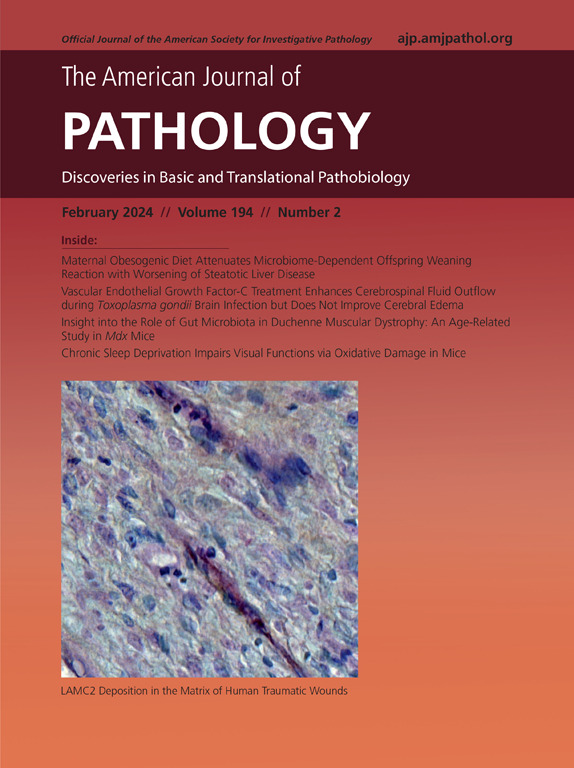Involvement of Heat Shock Protein 47 in Osteophyte Formation of Knee Joint Osteoarthritis
IF 4.7
2区 医学
Q1 PATHOLOGY
引用次数: 0
Abstract
Osteophytes contribute to the development and progression of knee osteoarthritis (OA). Although transforming growth factor-β (TGF-β) and bone morphogenic protein-2 (BMP2) are known to induce osteophytes, regulators of osteophyte formation remain elusive. This study aimed to search for molecules that modulate osteophytosis in a mouse knee OA model. Proteomic analysis, followed by immunohistochemistry of osteophyte and articular cartilage, identified heat shock protein 47 (HSP47), a molecular chaperone for procollagens, as a molecule selectively overexpressed by osteophyte fibrocartilaginous cells. The treatment of TGF-β3 and BMP2 to a three-dimensional pellet culture of mouse mesenchymal stem cells caused their differentiation into osteophyte-like cells accompanied with the up-regulation of HSP47. The pellet sizes of stimulated three-dimensional–cultured mesenchymal stem cells were significantly reduced by knockdown of HSP47 or treatment with AK778 (HSP47 inhibitor), because of increased apoptosis. Furthermore, intra-articular AK778 injections suppressed osteophyte formation in a mouse OA model. Importantly, the studies with human samples demonstrated HSP47 overexpression by osteophyte fibrocartilaginous cells in human OA knee joints. Similarly, the overexpression of HSP47 was observed in the TGF-β3– and BMP2-treated human osteophytic cell spheroids as well as the size reduction of spheroids by AK778 treatment. These findings highlight the promoting function of HSP47 in osteophyte formation in OA knee joints and suggest that therapeutic interventions targeting HSP47 may be of clinical value.
热休克蛋白47在膝关节骨关节炎骨赘形成中的作用。
骨赘有助于膝骨关节炎(OA)的发展和进展。虽然已知转化生长因子-β (TGF-β)和骨形态发生蛋白-2 (BMP2)可诱导骨赘形成,但骨赘形成的调节因子仍然难以捉摸。本研究旨在寻找调节小鼠膝关节OA模型骨赘病的分子。骨赘和关节软骨的蛋白质组学分析和免疫组化发现,热休克蛋白47 (HSP47)是前胶原的分子伴侣,是骨赘纤维软骨细胞选择性过表达的分子。TGF-β3和BMP2对小鼠间充质干细胞进行三维颗粒培养,使其向骨赘样细胞分化,并伴有HSP47的上调。抑制HSP47或用AK778 (HSP47抑制剂)处理后,受刺激的三维培养间充质干细胞的颗粒大小明显减小,因为细胞凋亡增加。此外,在小鼠OA模型中,关节内注射AK778可抑制骨赘的形成。重要的是,对人类样本的研究表明,HSP47在人类OA膝关节的骨赘纤维软骨细胞中过表达。同样,在TGF-β3-和bmp2处理的人骨赘细胞球体中也观察到HSP47的过表达,AK778处理的人骨赘细胞球体变小。这些发现强调了HSP47在OA膝关节骨赘形成中的促进作用,并提示针对HSP47的治疗干预可能具有临床价值。
本文章由计算机程序翻译,如有差异,请以英文原文为准。
求助全文
约1分钟内获得全文
求助全文
来源期刊
CiteScore
11.40
自引率
0.00%
发文量
178
审稿时长
30 days
期刊介绍:
The American Journal of Pathology, official journal of the American Society for Investigative Pathology, published by Elsevier, Inc., seeks high-quality original research reports, reviews, and commentaries related to the molecular and cellular basis of disease. The editors will consider basic, translational, and clinical investigations that directly address mechanisms of pathogenesis or provide a foundation for future mechanistic inquiries. Examples of such foundational investigations include data mining, identification of biomarkers, molecular pathology, and discovery research. Foundational studies that incorporate deep learning and artificial intelligence are also welcome. High priority is given to studies of human disease and relevant experimental models using molecular, cellular, and organismal approaches.

 求助内容:
求助内容: 应助结果提醒方式:
应助结果提醒方式:


